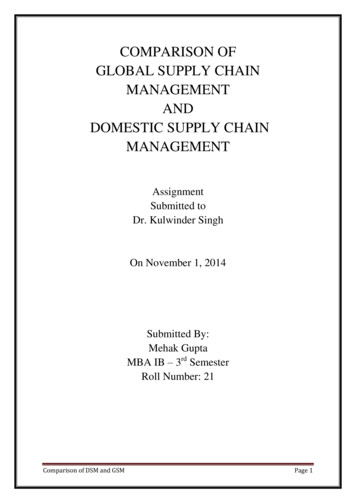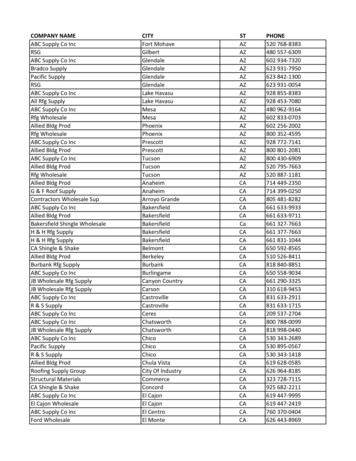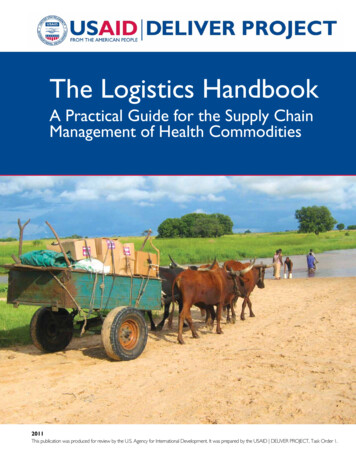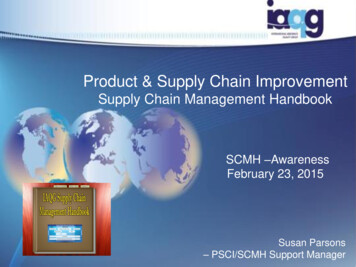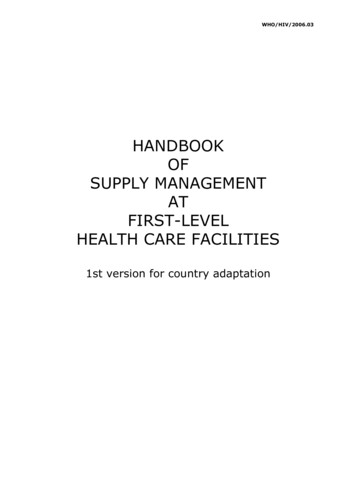
Transcription
WHO/HIV/2006.03HANDBOOKOFSUPPLY MANAGEMENTATFIRST LEVELHEALTH CARE FACILITIES1st version for country adaptation
World Health Organization 2006All rights reserved.The designations employed and the presentation of the material in this publication do not imply theexpression of any opinion whatsoever on the part of the World Health Organization concerning the legalstatus of any country, territory, city or area or of its authorities, or concerning the delimitation of itsfrontiers or boundaries. Dotted lines on maps represent approximate border lines for which there may notyet be full agreement.The mention of specific companies or of certain manufacturers’ products does not imply that they areendorsed or recommended by the World Health Organization in preference to others of a similar naturethat are not mentioned. Errors and omissions excepted, the names of proprietary products aredistinguished by initial capital letters.All reasonable precautions have been taken by WHO to verify the information contained in thispublication. However, the published material is being distributed without warranty of any kind, eitherexpress or implied. The responsibility for the interpretation and use of the material lies with the reader. Inno event shall the World Health Organization be liable for damages arising from its use.
AcknowledgementsThe following organizations and individuals are thanked for their contribution to thehandbook:Ecumenical Pharmaceutical Network: Kandeke Chipupu (Churches Health Association ofZambia)International Dispensary Association Solutions: Heather HoulihanJohn Snow Inc./DELIVER: Greg Roche, Albert Mugume (Uganda), Cecilia Sewagudde(Uganda)Management Sciences for Health (Rational Pharmaceutical Management Plus):Ross HollandMinistry of Health Lesotho: Masoko Ntsekhe, Lerato Kholokholo, Mamojalefa Matsoara,Palesa MokoenaPartners in Health: Ashwin VasanReMeD: Veronique Grouzars, Carinne Bruneton, Caroline Damour, Philippe BousharainUnited States Agency for International Development: Roxana Rogers and Samuel HopeUnited Nations Children's Fund: Hélène MöllerWHO/Representative (Lesotho): Hlabana Mohlakola, Esther AcengWHO/ Representative (Uganda): Moses Mutebi, Abdikamil AlisaladWHO/Regional Office for Africa: Moses ChisaleWHO/HIV/AIDS Medicines and Diagnostics Service: Kenji Tamura, Peter Graaff,Jos PerriënsWHO/HIV/Partnerships, External Relations and Communication: Kwonjune SeungWHO/Medicines Policy and Standards: Marthe Everard, Clive OndariWHO/Technical Cooperation for Essential Drugs and Traditional Medicine: Helen Tata,Gilles ForteThanks are due to Susan Kress (Winthrop University, USA) for her editorial workthroughout the development of the Handbook.The financial support of USAID is gratefully acknowledged. The opinions expressed inthe Handbook are those of the authors alone.
ContentsINTRODUCTION. 11. How to prepare the pharmacy store . 32. How to organize supplies . 73. How to keep records of supplies.134. How to order supplies based on past consumption .215. How to start antiretroviral treatment services .296. How to scale up antiretroviral treatment services .397. How to receive supplies .458. How to dispense medicines .519. How to receive payment .58ANNEXESANNEX 1 –Physical Conditions Checklist .62ANNEX 2 –Storage Procedures Checklist .63ANNEX 3 –Stock Card Checklist .64ANNEX 4 –Ordering Supplies Checklist .65ANNEX 5 –Receiving Supplies Checklist .66ANNEX 6 –Dispensing Procedures Checklist .67ANNEX 7 –Stock Card.68ANNEX 8 –Monthly Report and Requisition Form .69ANNEX 9 Requisition and Issue Voucher69ANNEX 10 – Requisition for Pharmaceutical Supplies Form.71ANNEX 11 – Delivery Form .72ANNEX 12 – Discrepancy Report Form .73
IntroductionAll first-level health care facilities, namely primary health care clinics and outpatientdepartments based in district hospitals, use medicines and related supplies. It takes a team effortto manage these supplies, involving all health care facility staff: doctors, nurses, health workersand storekeepers. This is especially true in small facilities with only one or two health workers.Each staff member should know how to manage all supplies at the health care facility correctly.Each staff member has an important role.The Handbook of Supply Management at First-Level Health Care Facilities describes all majormedicines and supply management tasks, known as the standard procedures of medicinessupply management1 at first-level health care facilities. Each chapter covers one major task,explains how the task fits into the process of maintaining a consistent supply of medicines, andrecommends which standard procedures to use. Annexes at the back of the handbook containvarious checklists and examples of forms which can be introduced as needed at your health carefacility.This handbook is part of a package used in an integrated training and capacity-building coursetargeted at first-level health care facilities. It can be used in conjunction with the existingIntegrated Management of Adult and Adolescent Illness (IMAI) strategy developed by WHO. Itcan also be used for basic training activities independent of IMAI training courses.After training, health workers returning to their health care facilities should explain the standardmedicines management procedures to their staff. Whenever possible, all the facility's staffshould rotate through the pharmacy store and dispensary to learn these procedures so thatsupplies will be managed correctly.Ideally health workers who have been trained will receive structured follow-up visits. This maybe part of routine monitoring and supportive supervision to ensure that what was learnt by thetrained health workers is implemented correctly. During these follow-up visits, the trainedhealth workers are supported to further improve their supply management practices.Different countries have different ways of managing their delivery and distribution of medicinesand related supplies. Some of the procedures described in this handbook may differ slightlyfrom practices existing in different countries. In addition, some tasks described may not berelevant for some first-level health care facilities. If in doubt about any of the procedures in thehandbook, national programme or district coordinators or supervisors should be contacted forfurther clarification. This handbook should be used in support of national training activities insupply management.1The contents are based on the publication Drug Supply Management Training. Geneva: WHO and BASICS; 1998.1
1. How to prepare the pharmacy storeMedicines and related supplies, for example laboratory test kits and reagents, are expensive andvaluable, especially medicines and diagnostics for HIV and AIDS. They need care otherwisethey may deteriorate. If they deteriorate, they may lose their potency, have the wrong effects onpatients or, in the case of test kits, they may produce incorrect results.Therefore, items in stock should always be stored in a proper storage space. Your health carefacility should have a room that can be locked, that is in good condition and is well organized.That room will be your pharmacy store. It should be separate from where you dispensemedicines. You should keep all supplies in the store and take (or issue) what you need dailyfrom the store to a dispensing area. If your health care facility does not have a room to use as apharmacy store, you should have a lockable cupboard or cabinet with shelves to serve as your"store".For a quick reference on procedures related to physical conditions, see the Physical ConditionsChecklist in Annex 1.IT IS IMPORTANT TO ARRANGE YOUR STORE ROOM PROPERLY(Boxes should be stored with sufficient space from the wall and from the floor)Source: JSI/WHO/UNICEF. Guidelines for the storage of essential medicines and other healthcommodities. Arlington, VA.: John Snow Inc./DELIVER; 2003.3
HANDBOOK OF SUPPLY MANAGEMENT AT FIRST LEVEL HEALTH CARE FACILITIESTo prepare a store at your health care facility1. Choose a secured room at your health care facility to be the store.Keeping supplies in a store makes it easy for you to always know what supplies you have. It isalso a simple way to keep supplies safe. Secure all openings with grills or bars to prevent theft.The store should be large enough to fit all of the supplies. It should be a room or, in the case of avery small health care facility, a cupboard or cabinet that is kept locked. Inside the store, thereshould be an additional secured area where narcotics and expensive items such as antiretroviral(ARV) medicines for HIV and AIDS are kept.a. Lock your store.Ideally, put two locks on the door of the room or cabinet. The locks should havedifferent keys. Limit the number of keys that are made, especially for areas wherenarcotics and expensive items are kept.Limit access to the store. Only the most senior storekeeper or pharmacist, and perhapsone other staff member, should have access to the store.Locking the store helps to control the movement of stocks. It also prevents medicinesand other supplies from disappearing.2. Keep your store in good condition.In principle, extreme temperatures, light or humidity may affect medicines and cause supplies todeteriorate. Heat affects all medicines, especially liquids, ointments and suppositories. Somemedicines which are light sensitive, such as injectables, spoil very quickly when exposed to light.Humidity can spoil tablets and capsules as they can easily absorb water from the air makingthem sticky and causing them to deteriorate. All products need to be kept in their originalpackaging, containers or boxes. Follow the storage instructions given on the labels.a. Inspect the physical structure of the store regularly.Repair any damage to the roof, walls, door, windows and floor.b. Control the temperature in the store.Check that there is a ceiling in the store. If there is no ceiling, build one. You could usecardboard from discarded boxes.Allow warm air to escape. Open the door and windows while someone is in the store.Put air vents in the walls or ceiling.Be aware that refrigerators standing in the same room generate additional heat. This canraise the temperature in the room. If you have a fan, use it. Keep it in good workingcondition. If your store is small and refrigerators raise the temperature, move them outto other place and put two security locks on the door of the refrigerator.4
HANDBOOK OF SUPPLY MANAGEMENT AT FIRST LEVEL HEALTH CARE FACILITIESc. Control the light in the store.If light enters the store through windows, block the direct light. Either paint thewindows white or hang curtains.d. Prevent water damage and control humidity.Check that there is good drainage. There should be drainage channels around yourstore. The roof should have gutters.Allow air to move freely. Secure the air vents and windows.Repair leaks as soon as they occur, to reduce moisture and water damage.Containers of tablets and capsules may be packed with a sachet of desiccant (non-edibledrying crystals). The desiccant keeps the inside of the container dry. Do NOT open thesachet. Keep the sachet in the container. Keep the container closed except whendispensing the medicines.e. Keep the store free of pests.Some common pests are rats, cockroaches, ants and wasps. Spilled items may attractpests. Clean spills and remove broken containers immediately. Use screens to keep outinsects.3. Keep your store clean and organized.In a clean and organized store, it is easy to find supplies. The supplies are likely to be in goodcondition and ready to be used.a. Clean the store and keep it tidy.Dust contaminates supplies and makes labels difficult to read. Spills and breakagescollect dirt.Mop the floor, dust the shelves and wipe down the walls regularly.b. Store supplies on shelves.Using shelves is an easy way to organize supplies.If there are no shelves in your store, make temporary shelves. Use boxes, stacked bricksand boards or pallets. Do NOT put boxes or boards directly on the floor. The floor maybe wet. Moisture may rot the cardboard or wood.Boxes and boards should be regarded as a temporary measure while you wait foradequate shelves to be made. Air should circulate around the boxes, which should bestored with sufficient space from the wall and from the floor (see page 3).5
HANDBOOK OF SUPPLY MANAGEMENT AT FIRST LEVEL HEALTH CARE FACILITIESc. If there is a refrigerator or freezer, keep it in good working condition.Use the refrigerator to store heat sensitive medicines and laboratory supplies. Openingand closing the door may increase the temperature and cause medicines or test kits todeteriorate. Do NOT keep staff food in the refrigerator.Follow the instructions you received from your supervisor or district coordinator on howto pack a refrigerator or freezer.Record the temperature daily. Check that there is enough space around the refrigeratorso that air can move freely.KEEPING YOUR STORE CLEAN AND TIDYMAKES MANAGING YOUR SUPPLIES EASIER!6
2. How to organize suppliesThe organization of medicines and related supplies in the pharmacy store should facilitate theservices offered at your health care facility. Anyone who works in your store should have accessto and be able to find supplies easily.All products should be stored in their original containers at all times. Similar supplies should beshelved together, arranged in alphabetical order or by therapeutic class or by classified groups(e.g. injectables, tablets, sundries) using their generic name. Items with a shorter shelf-life (shortexpiry dates or older stock) should be placed in front of similar items with a longer shelf-life(later expiry dates or newer stock).For a quick reference on storage procedures, see the Storage Procedures Checklist in Annex 2.ALWAYS KNOW WHAT YOU HAVE IN YOUR STORE(make sure that the expiry dates are visible while the products are in storage)Source: JSI/WHO/UNICEF. Guidelines for the storage of essential medicines and other healthcommodities. Arlington, VA.: John Snow Inc./DELIVER; 2003.7
HANDBOOK OF SUPPLY MANAGEMENT AT FIRST LEVEL HEALTH CARE FACILITIESTo organize medicines and related supplies in your storeFollow the procedures below in the regular storage area, the refrigerated area and in the securearea.1. Store similar items together on the shelves.When organizing supplies, "similar" refers to the route of administration (external, internal orinjectable) and form of preparation (dry or liquid medicines).Store medicines in the following classified groups: externals, internals and injectables. Shelvetablets and capsules together. Shelve liquids and ointments together. Shelve other suppliestogether. Organize each group of items in alphabetical order.In the case of ARVs, store them separately from other medicines, e.g. in a lockable cupboard orcabinet. Arrange by therapeutic class or by their inclusion in first-line, substituted first-line orsecond-line antiretroviral treatment (ART) regimens.In the case of controlled substances, such as narcotics and other opioid analgesics andpsychotropic medicines, always store these substances in a secure area and in accordance withnational guidelines.EXAMPLE: STORING SIMILAR MEDICINES TOGETHER In the pharmacy store of the Taylor Clinic, ketoconazole 2% cream and ketoconazole 200mg tablets are available. The cream is put on the skin (external) and the tablets are takenorally (internal). The health worker stores the cream with the externals and the tabletswith the internals. Also in the store, amoxicillin 250 mg tablets and amoxicillin 125 mg/5 ml oral suspensionare available. Both items are internals. The health worker stores the tablets with the othertablets and capsules. The oral suspension is placed with other liquids. A new supply of nevirapine tablets has arrived. The health worker stores the tablets in alocked cabinet with the other ARV tablets that are available.If there are three or more shelves in your store, organize your supplies in the following way:TOPSHELVESStore dry medicines (tablets, capsules, oral rehydration packets). Useairtight containers.If the top shelf is near the ceiling or out of your reach, use that shelf to storeitems that are NOT sensitive to heat and are NOT used regularly.MIDDLESHELVESBOTTOMSHELVESStore liquids, including injectables and ointments.Do NOT put dryl medicines below them. If liquids leak, the medicines mayspoil.Store other supplies, such as surgical items, laboratory supplies, condomsand labels.Remember, do NOT store anything directly on the floor.8
HANDBOOK OF SUPPLY MANAGEMENT AT FIRST LEVEL HEALTH CARE FACILITIESStore items, such as lopinavir/ritonavir and HIV test kits, in a refrigerator or freezer inaccordance with the manufacturer’s instructions.2. Find the generic name of each medicine in your store.The generic name of a medicine should be listed on its label. The generic name is different fromthe brand name. The generic name is the chemical name of the medicine. The brand name is aname given by the manufacturer.There may be many brand names for the same generic medicine. For example, some of thebrand names for cotrimoxazole (sulfamethoxazole trimethoprim) are Cotrex, Cotrim, Bactrimand Septrin.3. Arrange and label the supplies on the shelves.Within each group, arrange the supplies in alphabetical order by generic name. Allow enoughspace for each item.Group identical items in amounts that are easy to count, such as in pairs or groups of five or ten.Store injectables in groups of ten.Print the generic name of each item on a label. Attach the label to the front of the items on theshelf.When you organize your supplies in this way, it will be easy for you to see what and how muchyou have. You will be less likely to confuse items that are similar in appearance or name.4. Store all medicines and related supplies with expiry dates by using"FIRST EXPIRY FIRST OUT" procedures.Manufacturers print dates on containers to show how long the contents will remain effective.The dates are called expiry dates. After the expiry date, medicines may have reduced, adverse orno effects on patients. Expired tests for HIV and AIDS may give a false result. As a generalprinciple, do NOT use expired products.At regular intervals check all stocks in your store for expiry dates. Put items with shorter expirydates in front of those with longer expiry dates. If two containers have the same expiry date, putthe newly received one behind the one already on the shelves.This method is referred to as FEFO, which is FIRST EXPIRY FIRST OUT. FEFO procedures reducewaste caused by product expiry.The order in which you receive products is not necessarily the order in which they will expire.Products you received most recently may expire sooner than the products you received earlier.It is extremely important to check expiry dates and to make sure that the dates are visible whilethe products are in storage.9
HANDBOOK OF SUPPLY MANAGEMENT AT FIRST LEVEL HEALTH CARE FACILITIES5. Store medical supplies and other commodities without expiry dates byusing "FIRST IN FIRST OUT" procedures.Store items with no expiry dates (e.g. soaps and detergents) in the order received. Put newlyreceived items behind the items already on the shelves. There may be a manufacture date on thecontainer, indicating the older stock that should be used first.This method is referred to as FIFO, which is FIRST IN FIRST OUT.6. Remove expired and poor quality items from the store.Poor quality or damaged medicines and related supplies are as risky as expired ones. Productsof different types, such as liquids, tablets and injectables, show damage in different ways.The Indicators of Poor Quality or Damaged Supplies List (see box) describes what to look forwhen identifying poor quality items. Use it to help you determine unacceptable items in yourstore.a. Identify all expired and other poor quality medicines and related supplies.Follow your health facility’s policy. In case of doubt, contact your supervisor or districtcoordinator.b. Identify overstocked items and any items that are no longer used at yourhealth care facility.If items are still within their expiry date, arrange for them to be returned to central storesor sent to other facilities where they are needed. Follow your health facility’s policy toremove these items. In case of doubt, contact your supervisor or district coordinator.c. Keep a record of the removal of medicines and related supplies.You will learn about record-keeping in the next chapter, How to Keep Records ofSupplies. Each time you remove a poor quality or damaged item from your store, makesure you put it in writing. Note the date, time, name of a witness and manner of removalon the card. Follow your health facility’s policy to remove these items. In case of doubt,contact your supervisor or district coordinator.ORGANIZING YOUR STOREMAKES IT EASIER FOR YOU TO MANAGE!10
HANDBOOK OF SUPPLY MANAGEMENT AT FIRST LEVEL HEALTH CARE FACILITIESINDICATORS OF POOR QUALITY OR DAMAGED SUPPLIESPACKAGING, LOOK FOR: Broken or ripped packaging (vials, bottles, boxes, etc.)LABELS, LOOK FOR: Missing, incomplete or unreadable labelsIF LIQUIDS, LOOK FOR: IF TABLETS (PILLS), LOOK FOR: DiscolourationCloudinessSedimentBroken seal on bottleCracks in ampoule, bottle or vialDampness or moisture in packagingTorn or ripped packagingIF CAPSULES, LOOK FOR: IF LATEX PRODUCTS, LOOK FOR: ushed capsulesIF INJECTABLES, LOOK FOR: IF LUBRICATED LATEX PRODUCTS,LOOK FOR: Sticky packaging Discoloured product or lubricant Stained packaging Leakage of the lubricant (moist ordamp packaging)Liquid not returning to suspensionafter shakingIF STERILE PRODUCTS (includingintrauterine devices), LOOK FOR: IF FOIL PACKS, LOOK FOR: DiscolourationCrumbled pillsMissing pills (from blister pack)Stickiness (especially coated tablets)Unusual smellTorn or ripped packagingMissing partsBroken or bent partsMoisture inside the packagingStained packagingPerforations in the packagingIF TUBES, LOOK FOR: IF CHEMICAL REAGENTS, LOOK FOR: DiscolourationStickinessLeaking contentsPerforations or holes in the tubeAdapted from: JSI/WHO/UNICEF. Guidelines for the storage of essential medicines and otherhealth commodities. Arlington, VA.: John Snow Inc./DELIVER; 2003.11
3. How to keep records of suppliesIt is important to keep good records of all of the medicines and related supplies you have instock. This helps you to understand the flow of supplies into and out of your health care facility.You will also know: What items are available in stockHow much is available of each item in stockHow much stock is used on a regular basisWhen and how much of an item should be reordered.Keeping records serves as the basis for the information needed when ordering new stocks ofmedicines and other supplies. This is especially important for chronic care programmes that willcontinue to enrol new patients, such as chronic HIV care and ART for HIV and AIDS patients.Keeping records saves you time and protects you. If you are accused of theft or misuse ofsupplies, you will be able to refer to your records. Your records will document the movement ofsupplies. They can show that you are not responsible for the problem.There are different ways of keeping records. The procedures recommended in this chapter arebased on the use of a standard stock card format. Your health care facility or programme mayhave its own stock card format. Stock cards can be made or modified to fit any type of recordkeeping system.SPECIAL DONOR REQUIREMENTSDonors may have special donor requirements for medicines and related supplies that they give tohealth facilities. Know the requirements before you accept such donations. Some examples ofspecial donor requirements may include: Restricting those to whom the donated treatment can be supplied (e.g. nevirapinedonation for Preventing Mother to Child Transmission only). Limiting which health care facility staff can prescribe the donated items to patients (e.g.only physicians allowed to write prescriptions for antiretroviral medicines).If your facility accepts such donations, make sure your team knows if there are special donorrequirements, what they are and how they apply to the management of medicines and relatedsupplies in your store.KEEPING RECORDSFor special recording and reporting requirements, it is likely that you will keep the donor’s itemsseparate from the same items that your facility received from the central store or other regularsuppliers. In such cases: You will also have to keep separate stock records. Be sure you know how to do this and have the required forms available as soon as thedonor’s shipment of supplies arrives.For a quick reference on record-keeping procedures, see the Stock Card Checklist in Annex 3and the Stock Card in Annex 7.13
HANDBOOK OF SUPPLY MANAGEMENT AT FIRST LEVEL HEALTH CARE FACILITIESThe stock cardThere should be a stock card for each item in your store. Keep the stock card with the item onthe shelf. Use the stock card to track the movement of the item. Record when and how the itemis used. This includes all movements, such as when a new shipment of an item arrives at thestore, when an item is moved out of the store room to the dispensary, or when an item isdispensed directly to a patient.If your health care facility receives supplies from donors, there may be special requirements.Follow the instructions you have received from your supervisor or district coordinator.See the example of a stock card below. The top of the stock card lists: Item, name of product including its form and strengthCode number, number that identifies the item, if there is oneUnit size, type of container: tin, bottle, tube, blister package, etc. amount of item inthe containerPrice, per unit cost, if this information is collected at your health care facilityReorder level, number of units needed in stock, below which an order should be placedto reach this level once again (threshold level for re-ordering).Name and address of your facility, if needed. EXAMPLE: STOCK CARDITEM:CODE NUMBER:UNIT OQUANTITYISSUEDBALANCEIN STOCKREORDER LEVEL:REMARKSSIGNATUREThere may be an item in your store that has different forms, strengths or unit sizes.Examples of differences are: Forms: a medicine can be in tablet, liquid or ointment formStrengths: e.g. amoxicillin can be in 250 mg tablets or 500 mg tabletsUnit sizes: a tin of tablets can contain 50, 100, 500 or more tablets.If you have an item in your store with more than one form, strength or unit size, use a separatestock card for each one. Do NOT use the same card for different forms, strengths or unit sizesof an item.14
HANDBOOK OF SUPPLY MANAGEMENT AT FIRST LEVEL HEALTH CARE FACILITIESThe stock card also has columns for information about movement of the item: DATE,when item is received into the store or issued out of the storeRECEIVED FROM, name of supplierQUANTITY RECEIVED, number of units received at the storeISSUED TO, name of dispensing area where item will be dispensed to patientsQUANTITY ISSUED, number of units issued out of the storeBALANCE IN STOCK, number of units remaining in the storeREMARKS, important information about the movement of the item, batch numbers, expirydates, borrowed from or returned to other health facility etc.SIGNATURE, person who records the movement of the item.When you record information on a stock card: Use a pen to record ITEM, CODE NUMBER, and UNIT SIZE and all information about themovement of the item. This information does not change.Use a pencil for the PRICE and REORDER LEVEL. This information may change. (REORDERLEVEL is discussed in the next chapter, How to Order Supplies).Use a
medicines and supply management tasks, known as the standard procedures of medicines supply management1 at first-level health care facilities. Each chapter covers one major task, explains how the task fits into the process of maintaining a consistent supply of me





